Changes in legislation in 2021
In 2021, the Federal laws came into force concerning: changes in administrative, criminal and tax legislation, the scopes of state control, licensing and audit of reporting, the creation of new information systems, the activities of foreign companies.
Administrative and criminal legislation
The Federal Law No. 206-FL of June 11, 2021 introduced amendments to the Code of Administrative Offenses of the Russian Federation, tightening the liability for disclosing the limited access information and establishing administrative liability for illegal obtaining limited access information. Moreover, the Federal Law No. 216-FL of June 11, 2021 amended Art. 183 and 320 of the Criminal Code of the Russian Federation, clarifying the rules on the illegal disclosure of commercial and tax secrecy, and banking confidentiality, as well as information on security measures in relation to officials of law enforcement or regulatory agencies.
Federal Tax Service
From January 1st, 2021 the Chapter 26.3 of the Tax Code of the Russian Federation “Tax system in the form of the unified tax on imputed income for certain activities” is declared to be no longer in force, in accordance with the Federal law as of June 29, 2012 №97-FL.
Legal entities, having paid the unified tax on imputed income (UTII), have a right to use the simplified tax system (STS) in future as one of the tax regimes, meaning special procedure of tax payment and focused on small and medium business.
From April 24, 2021 the Federal Law No. 350-FL of October 27, 2020 came into force with amendments to Article 5 of the Federal Law “On State Registration of Legal Entities and Individual Entrepreneurs”. The law clarified the content of the Unified State Register of Legal Entities in relation to limited liability companies and joint stock companies. Some information about legal entities and individual entrepreneurs is now entered into the Unified State Register of Legal Entities by the registration authorities independently. The period within which legal entities and individual entrepreneurs are obliged to notify the registration authorities about changes in the information contained in the Unified State Register of Legal Entities has been increased from 3 to 7 working days.
The Federal Law No. 374-FL of November 23, 2020 amended parts one and two of the Tax Code of the Russian Federation and certain legislative acts. The main changes concerning legal entities are as follows:
- since January 1, 2021 it is established that in respect of a dead or destroyed taxable object, the calculation of property tax is terminated from the 1st day of the month of death/destruction on the basis of the relevant application submitted by the taxpayer to the tax authority by its own choice
- since July 1, 2021, the tax returns will be considered as unreported if the fact of signing by unauthorized persons or non-complaining of their indicators with standards will be found. For such cases, the features of termination and resumption of desk audit were established.
The Federal Law No. 470-FL of December 29, 2020 amended the RF Tax Code providing for a significant reduction in the criteria for tax monitoring.
The Federal Law No. 6-FL of February 17, 2021 amended the Article 86 of Part I of the Tax Code of the Russian Federation to oblige credit institutions to provide tax authorities with documentation upon their requests.
As amended by the Federal Law No. 368-FL of November 9, 2020, from July 1, 2021 the tax authorities will receive the right to inform the taxpayers in advance on upcoming suspension of bank accounts.
Financial statements
The Federal Law No. 476-FL of December 29, 2020 introduced the amendments to the Law “On audit activities” concerning the conditions for the mandatory audit of financial statements.
Starting from January 1, 2021 financial indicators, exceeding the threshold values of which is the basis for conducting a mandatory audit of financial statements, have been increased. Non-profit organizations are exempted from the obligation to audit financial statements if certain conditions are met.
State statistics
The Federal Law No. 174-FL of June 11, 2021 imposes a duty to form the Enterprise Group Register on the Federal State Statistics Service (Rosstat).The Rosstat Order No. 566 of September 16, 2021 defined the list of information on investment activity of group companies.
State control, licensing
According to the Federal Law No. 247-FL of July 31, 2020 "On mandatory requirements in the Russian Federation", regardless of the recognition as invalid, not effective in the territory of the Russian Federation or canceled regulatory legal acts within the framework of the "regulatory guillotine", from January 1, 2021, when exercising state control, it is not allowed to assess compliance with mandatory requirements if they entered into force before January 1, 2020 It was also established that from January 1, 2021, non-compliance with the requirements contained in such acts will not be the basis for bringing to administrative responsibility if they entered into force before January 1, 2020.
From January 1, 2021, when exercising state control, granting licenses and other permits, accreditations, it is not allowed to assess compliance with the mandatory requirements contained in officially unpublished regulatory legal acts (with the exception of requirements constituting state secrets, related to legally protected or restricted information).
These provisions are not applied in the electric power industry, as well as in the implementation of public-private partnership projects with the participation of the Russian Federation.
The Federal Law No. 478-FL of December 27, 2019 established a transition from January 1, 2021 to a "registry model" in licensing, aimed at cessation of the paper-form licensing. Licenses are now confirmed by entries in the relevant register. Access to the license registers is publicly available.
In accordance with the Law above and the Decree of the Government of the Russian Federation No. 652 from April 26, 2021, a public not-for-profit organization "Unified Gambling Regulator" was founded; the organization is established to ensure the implementation of the legislation on state regulation of this activity. In this regard, according to the Decree of the Government of the Russian Federation No. 638 from April 24, 2021, regulations that oblige the Federal Tax Service of the Russian Federation to oversee this area will become invalid from September 27, 2021 .
The order of formation, maintenance, operation and development of the Unified Register of types of federal state control (supervision), regional state control (supervision) and municipal control was approved by the Russian Federation Government Decree No. 528 dated April 2, 2021. Inspections will be possible only in case when there are appropriate entries in the Register, which is maintained by the Prosecutor General's Office of the Russian Federation, starting July 1, 2021.
Information systems
In accordance with the Federal Law No. 488-FL of December 25, 2018, the State Information System for Monitoring the Turnover of Goods subject to mandatory labeling by means of identification was created, where the following goods are recorded and monitored: tobacco products, fur products, footwear, medicines, cameras (except for cinematographic cameras), photo flashes and flashlights, tires and tire casing, clothing and linen, perfume and eau de toilette, wheelchairs for the disabled, bicycles and bicycle frames, dairy products.
The turnover of unmarked goods will be forbidden since January 01, 2021. Unsold leftover stock must be marked by the participants till February 01, 2021.
The Federal Law No. 219-FL of June 28,2021 amended the Law of the Russian Federation "On Employment of the Population in the Russian Federation". The law came into force on July 1, 2021. The employers of all legal forms of ownership, state and municipal authorities, state and municipal institutions, unitary enterprises, organizations with state participation are required to post the following information on the Unified digital employment and labor relations platform "Work in Russia".
Foreign companies
The Federal Law No. 27-FL of February 24, 2021 amended the Article 21 of the Federal Law "On Foreign Investments in the Russian Federation", concerning the rules of accreditation of branches and representative offices of foreign legal entities.
The Federal Law No. 236-FL of July 1, 2021 establishes the procedure and conditions for foreign persons to operate on the Internet in Russia using information resources with an audience of more than 500 thousand Russian users per day.
Coal mining trends
The last UN Climate Change Conference (COP26) ended with the adoption of compromise documents. Previously, it was planned to fix the wording on the phase-out of energy obtained from coal. However, only a "phased reduction" is recorded in the final text. This indicates the impossibility of abandoning the use of coal as one of the main types of fuel and preserving the prospects of Russia as a global supplier of coal.
Coal mining industry of the country, experiencing difficulties associated with ensuring the safety of the work carried out, continues to develop.
Among the positive trends of the largest enterprises in the industry over the past 10 years, there has been an increase in the size of net assets and revenue, an increase in return on investment, and a continuing positive index of industrial production over the past 12 months.
Among the most significant negative trends: a high level of monopolization, instability of profit indicators and an increase in unprofitability, which leads to a decrease in the financial stability of enterprises.
To analyze activity trends in this area the Information agency Credinform using Globas selected the largest companies engaged in the extraction and enrichment of coal and anthracite (TOP 100) in terms of annual revenue for the last reporting periods available in the state statistics bodies and the Federal Tax Service (2015-2020).
Net assets is a ratio that reflects the real value of the company's property that is calculated annually as the difference between the assets on the company's balance sheet and its debt obligations. The net asset ratio is negative (insufficient property) if the company's debt exceeds the value of its property.
The largest company in the industry in terms of net assets is MEZHDURECHYE JSC, INN 4214000252, Kemerovo region - Kuzbass. In 2020, net assets amounted to more than 65 billion RUB.
The smallest size of net assets in the TOP 100 was owned by COAL COMPANY YUZHNAYA JSC, INN 4214021365, Kemerovo region - Kuzbass. The insufficiency of property in 2020 was expressed by a negative value of -69 billion RUB.
During the ten-year period, average industry indicators of net assets values and their growth rates tend to increase (Picture 1).
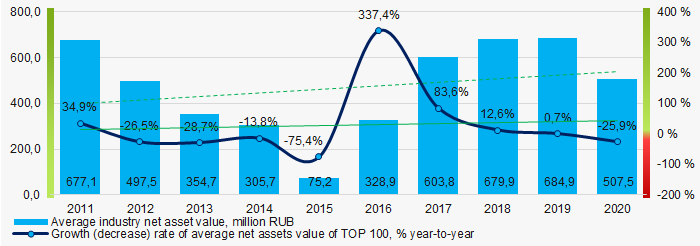 Picture 1. Change in average industry net assets ratios in 2011-2020
Picture 1. Change in average industry net assets ratios in 2011-2020The shares of companies with insufficient assets in the TOP 100 have had a positive downward trend for five years. (Picture 2).
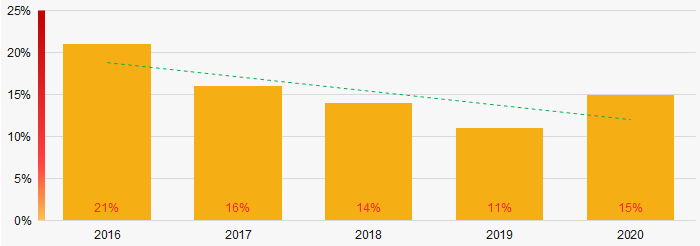 Picture 2. Shares of companies with negative net assets in the TOP 100 in 2016-2020.
Picture 2. Shares of companies with negative net assets in the TOP 100 in 2016-2020.Sales revenue
The revenue of the TOP 10 companies in 2020 amounted to 46% of the total revenue of the TOP 100 companies. (Picture 3). This indicates a high level of monopolization in the industry.
 Picture 3. Shares of TOP-10 companies in the total revenue in 2020. TOP-100
Picture 3. Shares of TOP-10 companies in the total revenue in 2020. TOP-100For ten years, the average industry indicators of revenue volumes have been increasing, and their growth rates have been decreasing year by year. (Picture 4).
 Picture 4. Changes in average industry revenue ratios in 2011-2020
Picture 4. Changes in average industry revenue ratios in 2011-2020Profit and loss
The largest company in the TOP 100 in terms of net profit in 2020 is JSC HOLDING COMPANY YAKUTUGOL, INN 1434026980, Republic of Sakha (Yakutia). Their profit amounted to almost 38 billion RUB.
During the ten-year period, the indicators of average industry profit margins tend to increase, despite losses over four periods. (Picture 5).
 Picture 5. Change in the average industry indicators of profit (loss) in 2012-2020.
Picture 5. Change in the average industry indicators of profit (loss) in 2012-2020.During the five-year period, the average industry values of net profit indicators are decreasing, and net loss is increasing (Picture 6).
 Picture 6. Changes in average values of net profit and net loss indicators of TOP 100 companies in 2016-2020.
Picture 6. Changes in average values of net profit and net loss indicators of TOP 100 companies in 2016-2020.Key financial ratios
During the ten-year period, average industry indicators of the total liquidity ratio were mainly below the range of recommended values - from 1.0 to 2.0, with a downward trend. (Picture 7).
Сurrent liquidity ratio (current assets to short-term liabilities) shows sufficiency of a company’s assets to settle short-term liabilities.
 Picture 7. Changes in current liquidity ratio average industry values in 2011-2020
Picture 7. Changes in current liquidity ratio average industry values in 2011-2020For ten years, the average industry indicators of the return on investment ratio were at a relatively high level and showed an upward trend. (Picture 8).
This ratio is calculated as a ratio of net profit to amount of equity and long-term liabilities and demonstrates return on equity involved in commercial activities and long-term funds raised by organization.
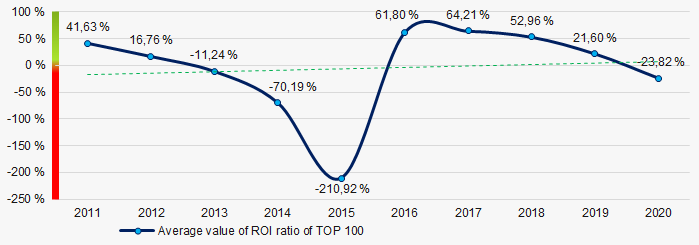 Picture 8. Change in return on investment ratio average values in 2011-2020
Picture 8. Change in return on investment ratio average values in 2011-2020Asset turnover ratio is calculated as ratio of sales revenue to average value of total assets for a period and implicates the efficiency of use of all available resources, regardless of the sources they were raised. The ratio shows how many times per year the full cycle of production and turnover is performed generating the corresponding effect in the form of profit.
During the ten-year period, average industry indicators of this business activity ratio tended to decrease (Picture9).
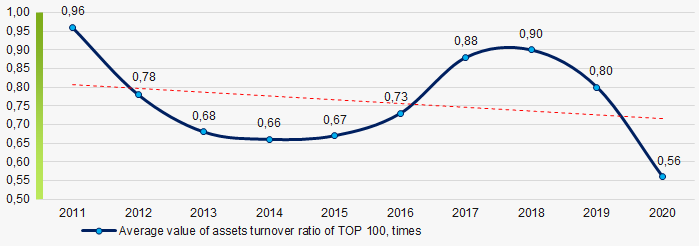 Picture 9. Change in asset turnover ratio average values in 2011-2020
Picture 9. Change in asset turnover ratio average values in 2011-2020Small enterprises
Only 2% of the TOP 100 companies are registered in the Unified Register of Small and Medium-sized Enterprises of the Federal Tax Service of the Russian Federation. At the same time, the share of their revenue in the total volume of the TOP 100 companies in 2020 is only 0.32%, which is significantly lower than the national average in 2018 - 2019. (Picture 10).
 Picture 10. Revenue share of small and medium-sized enterprises in the TOP 100
Picture 10. Revenue share of small and medium-sized enterprises in the TOP 100Main regions of activity
The TOP 100 companies are registered in 17 regions (20% of the subjects of the Russian Federation) and are distributed unevenly across the country due to the geographical specifics of shipbuilding industry. Almost 64% of the total revenue of TOP 100 companies in 2020 are concentrated in the Kemerovo region - Kuzbass (Picture 11).
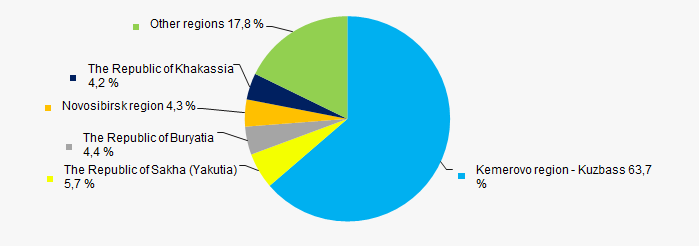 Picture 11. Distribution of TOP 100 companies' revenue by regions of Russia
Picture 11. Distribution of TOP 100 companies' revenue by regions of RussiaFinancial position score
Assessment of the of TOP 100 companies' financial position shows that the largest part of them is in an average financial position. (Picture 12).
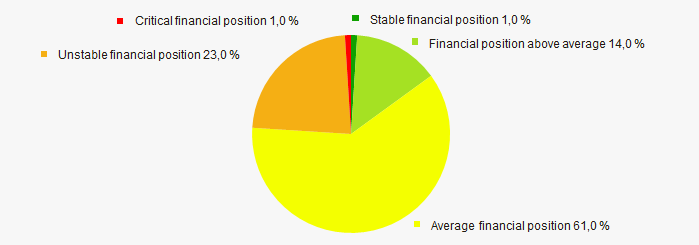 Picture 12. Distribution of TOP 100 companies by financial position score
Picture 12. Distribution of TOP 100 companies by financial position scoreGlobas Solvency Index
The largest part of the TOP 100 companies has been assigned a high Solvency Index by Globas. This indicates their ability to fully meet their debt obligations (Picture 13).
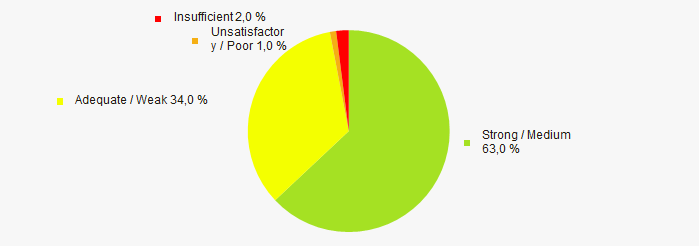 Picture 13. Distribution of TOP 100 companies according to the Globas Solvency Index
Picture 13. Distribution of TOP 100 companies according to the Globas Solvency Index Industrial Production Index
According to the Federal State Statistics Service, during the 12 months of 2020 - 2021, there is an increase in the index of industrial production in coal mining (Picture 14). At the same time, the calculated average index from month to month is 100.9%.
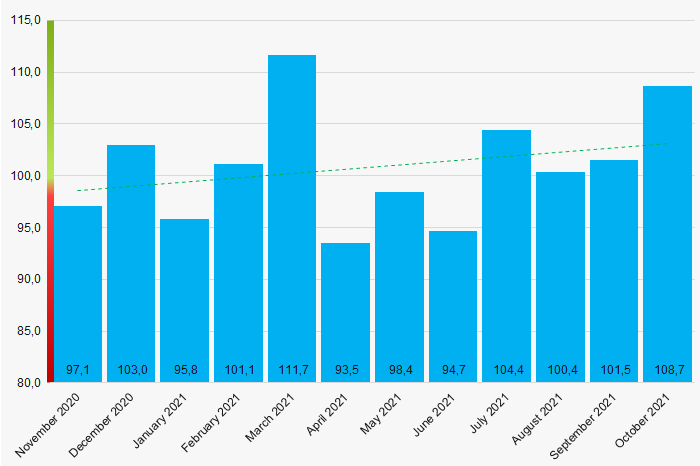 Picture 14. Industrial production index in coal mining in 2020 - 2021, month to month (%)
Picture 14. Industrial production index in coal mining in 2020 - 2021, month to month (%)Conclusion
Comprehensive assessment of the largest coal mining companies indicates the predominance of positive trends in their activities in the period from 2011 to 2020. (Table 1).
| Trends and evaluation factors | Share of factor, % |
| Dynamics of average net assets value |  10 10 |
| Increase (decrease) rate in the average value of net assets |  10 10 |
| Increase / decrease in share of enterprises with negative values of net assets |  10 10 |
| Level of monopolization / competition |  -10 -10 |
| Dynamics of average revenue |  10 10 |
| Growth (decline) rate in average value of revenue |  -10 -10 |
| Dynamics of average profit (loss) |  10 10 |
| Increase / decline in average values of companies' net profit |  -10 -10 |
| Increase / decline in average values of companies' net loss |  -10 -10 |
| Increase / decrease in average values of overall liquidity ratio |  -10 -10 |
| Increase / decrease in average values of return on investment ratio |  10 10 |
| Increase / decrease in average values of asset turnover ratio, times |  -10 -10 |
| Share of small and medium-sized enterprises in revenue is more than 20% |  -10 -10 |
| Regional concentration |  -5 -5 |
| Financial position (the largest share) |  5 5 |
| Globas Solvency Index (the largest share) |  10 10 |
| The average index of industrial production for 12 months is more than 100% |  10 10 |
| Dynamics of the Industrial Production Index for 12 months. |  10 10 |
| Average value of factors share |  1,1 1,1 |
 positive trend (factor),
positive trend (factor),  negative trend (factor)
negative trend (factor)